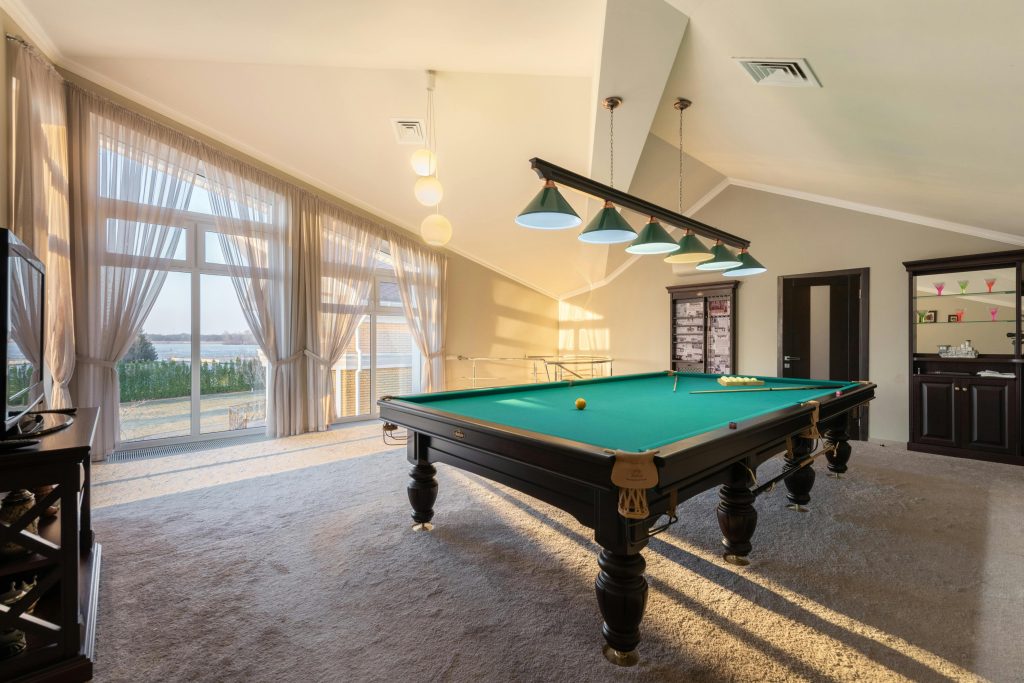Transforming a room in your home into a dedicated family game room is a fantastic way to encourage quality time, fun, and relaxation for everyone. Whether you’re designing a high-tech video gaming hub or a cozy space filled with board games and family-friendly activities, this guide will help you create the ultimate game room that perfectly suits your family’s needs.
Why Create a Family Game Room?

According to a 2024 survey conducted by the National Home Improvement Association (NHIA), over 60% of homeowners consider creating a family game room as a top priority for enhancing family time. Additionally, research from the American Psychological Association (APA) shows that families who engage in recreational activities together at least once a week are 75% more likely to report stronger emotional bonds and improved communication.
Creating a dedicated space for games and entertainment can improve family relationships, reduce stress, and promote creativity. It’s also an excellent way to keep kids entertained and encourage everyone to spend time away from their screens in a healthy, balanced way.
What This Guide Will Cover:
- How to select the right space and plan your layout
- Choosing games and entertainment systems for all ages
- Designing and decorating your game room for a unique ambiance
- Stocking up on snacks and beverages for convenience
- Practical tips for creating a space everyone will love
Ready to get started? Let’s dive in!
Defining Your Game Room Space
Creating a successful game room starts with choosing the right space and planning its layout effectively.
Step 1: Choose and Measure Your Space
Before diving into the fun part of designing your game room, you need to pick the right location. This could be an unused basement, attic, garage, or even a spare bedroom.
Things to Consider:
- Available Space: Measure the room’s dimensions and consider ceiling height, wall length, and overall square footage.
- Sound Control: Game rooms can get loud. Choose a space where sound won’t disturb others, or consider soundproofing if needed.
- Accessibility: The room should be easy to access for everyone in the family, including younger kids and older family members.
- Ventilation & Lighting: Ensure the room has proper ventilation and the ability to control natural and artificial light.
Step 2: Plan Your Layout

After choosing your space, plan out how you’ll arrange everything. Create a rough sketch or use digital design tools to visualize your room.
Key Elements to Include:
- Seating Area: Comfortable sofas, bean bags, or recliners for relaxation and gameplay.
- Entertainment Center: Space for a TV, projector, sound system, and gaming consoles.
- Game Tables: If desired, include foosball, air hockey, table tennis, or pool tables.
- Storage: Shelves, cabinets, or display cases for board games, collectibles, and controllers.
- Lighting: Adjustable lighting to suit different gaming experiences.
- Refreshment Station: A mini-fridge or snack bar for convenient food and drinks access.
Selecting Games and Entertainment Systems
Your game room should cater to everyone’s interests. From video games to board games and more, variety is key.
Step 3: Choose the Right Games
Identify the types of games your family enjoys most and include options for all ages.
Board Games & Card Games:
- Monopoly, Scrabble, Uno, and newer games like Catan or Exploding Kittens can provide hours of family fun.
- Store games in dedicated shelves or cabinets to keep everything organized.
Video Game Consoles:
- Popular options include PlayStation, Xbox, Nintendo Switch, and classic retro consoles.
- Consider investing in a high-quality TV or projector for an immersive gaming experience.
Physical Games:
- Adding table games like air hockey, foosball, or table tennis creates a versatile environment.
- These games offer physical activity and appeal to all age groups.
Step 4: Install Your Entertainment System
Setting up a central entertainment system enhances the overall game room experience.
Components to Include:
- Television or Projector: Choose a screen size that suits your space. Projectors work well for larger areas, while flat-screen TVs are better for smaller rooms.
- Sound System: A surround sound system or quality speakers can elevate the atmosphere.
- Streaming Devices: Consider adding devices like Roku or Apple TV to expand your media options.
- Gaming Consoles: Keep consoles in a centralized, well-ventilated area with easy access to controllers.
Designing and Decorating Your Game Room
Now comes the fun part: making your game room look amazing!
Step 5: Select a Theme and Color Scheme
Choosing a cohesive theme makes your game room feel special and inviting.
Popular Themes:
- Retro Arcade: Bright colors, classic arcade machines, and vintage posters.
- Sports Haven: Sports memorabilia, team colors, and themed decor.
- Modern Gamer’s Paradise: Sleek furnishings, LED lighting, and high-tech displays.
- Family-Friendly Zone: Cozy decor, soft seating, and accessible storage for everyone.
Step 6: Add Comfortable Seating
Comfort is essential for long gaming sessions. Make sure to provide enough seating for everyone.
Seating Ideas:
- Sectional sofas, bean bags, recliners, or floor cushions.
- Arranging seating to face the entertainment center ensures everyone has a great view.
Step 7: Install Proper Lighting
Lighting can dramatically enhance your game room’s ambiance.
Lighting Tips:
- Install dimmable ceiling lights for adjustable brightness.
- Use LED strip lights behind screens for a stylish effect.
- Add fun touches like neon signs or themed lamps to match your decor.
Step 8: Display Your Collections
If you have collectibles related to gaming, showcase them in a stylish way.
Ideas for Display:
- Wall-mounted shelves for action figures, board games, or memorabilia.
- Glass display cases to highlight special items.
- Shadow boxes or framed posters for a polished look.
Stocking Up on Snacks & Drinks
What’s a family game room without snacks and drinks?
Step 9: Create a Refreshment Station
Adding a refreshment area ensures you won’t have to pause the fun to grab food or drinks.
Snack Ideas:
- Chips, popcorn, candy, and pretzels.
- Healthy options like fruit and veggie trays.
- Mini-fridge with drinks for all ages.
Making Your Game Room a Fun, Functional Space
Now that you’ve created your game room, keep it enjoyable for everyone.
Step 10: Regular Maintenance and Updates
- Keep the space clean and organized.
- Rotate games and decorations to keep things fresh.
- Involve the whole family in maintaining the space.
Conclusion
Creating a family game room is more than just setting up a space with games. It’s about building a place for connection, laughter, and memories. By choosing the right games, designing the space thoughtfully, and adding personalized touches, you can create the perfect entertainment room that everyone in the family will love.
Ready to get started? Follow these steps, and you’ll be enjoying your perfect family game room in no time!
FAQs About Building a Family Game Room
1. What is the Best Room to Use for a Game Room?
The best rooms are basements, spare bedrooms, attics, or garages. Ensure proper ventilation, sound control, and accessibility.
2. How Much Does It Cost to Build a Family Game Room?
Costs can range from $500 for a basic setup to over $10,000 for high-end entertainment systems and decor.
3. What Are the Essential Items for a Game Room?
Seating, entertainment systems, lighting, storage solutions, and refreshment stations are essential.
4. Can I Combine a Home Theater with a Game Room?
Yes! Combining a home theater and game room can create a versatile entertainment space that everyone will enjoy.
Key Takeaways
- Building a family game room strengthens relationships, promotes fun, and encourages creativity.
- Choosing the right space and layout is essential for functionality and comfort.
- Incorporate games and entertainment systems that appeal to all age groups.
- Use creative themes, comfortable seating, and proper lighting to enhance the atmosphere.
- Regularly update and maintain the space to keep it exciting and fresh.
Creating a game room is more than just putting games in a room — it’s about crafting an inviting space that encourages connection, laughter, and lasting memories.


